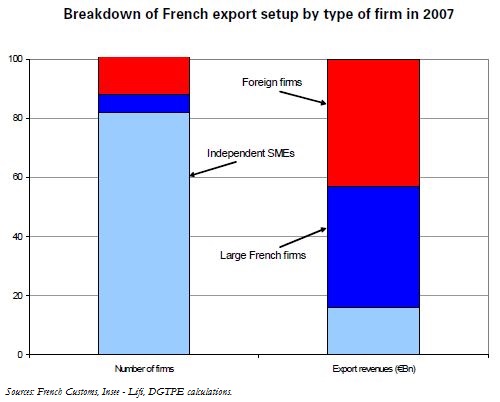Trésor-Economics No. 54 - The many faces of the French export setup
According to French Customs, some 100,000 French firms export goods, or nearly one firm in 20, This propensity to export is well below that of Germany, close to that observed in Italy, and greater than the figure for the United Kingdom and Spain.
A very small number of firms account for the bulk of these exports, with the top thousand exporters representing 70% of total export revenues. While independent SMEs represent the great majority of firms in France's export setup (see chart below), their share of export revenues is very small. Conversely, the large, highly-international French groups, together with companies belonging to international groups installed in France, account for the bulk of French export revenues. The contrast with SMEs is especially pronounced with respect to the extent of firms' international coverage.
The drop in the number of exporting firms in the 2000s (a fall of 9,000) is mainly attributable to independent SMEs, which tend to be small and often first-time exporters. Despite the scale of the decline in numerical terms, the firms no longer exporting in fact made only a marginal contribution to total export revenues (less than 1%).
Generally, French SMEs are restricted in their international development by their small size and limited innovative capacity. When they export, they export to just one or two countries, generally to neighbouring countries, and 30% fail to hold onto their market for more than a year. German SMEs, which are larger and more innovative, are also bigger exporters, with exports accounting for a larger share of their total revenue, and they also export more regularly.
Even so, a certain number of SMEs manage to take advantage of the opportunities afforded by external markets. Indeed, a third of exporting firms are independent SMEs that export regularly, i.e. for at least five consecutive years. There are several ways to achieve exporting success, as witnessed by the strong export performance of innovative SMEs and by SMEs backed by a group. An analysis of first-time exporters also shows that exporting is a multi-stage process.
The identification of a different "populations" of exporters ought to spur the authorities to adapt the various export mechanisms to the different categories of firm, to allow for the specific difficulties they encounter depending on their legal status, size, innovative capacity, and degree of maturity in exporting to international markets.
